
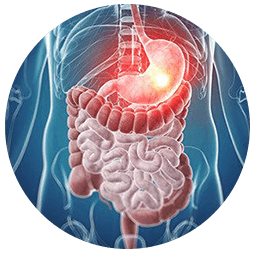
What is laparoscopic surgery?
Laparoscopy is an advanced surgical technique that allows the surgeon to look into the abdomen via a 5 or 10 mm telescope called a laparoscope. Major abdominal surgery can be performed using laparoscopic techniques, through tiny cuts that are typically 3 to 5 mm in size.

A hernia is a visible swelling or bulge over the abdomen, which occurs due to a weakness or tear in the abdominal muscles. Hernias commonly occur at the navel (umbilical hernia), in the groin (inguinal hernia) and over previous surgical scars (incisional hernia), but there are several other types of hernia as well. You may experience pain or discomfort at the site of hernia, but just as often, there may be a painless swelling. If left untreated, a hernia may develop complications like obstruction or strangulation, which require emergency surgery.
Most patients who develop a hernia will require surgical treatment. At Dr. Muffi Digestive Health Institute, you will first be examined by an expert surgeon to confirm the diagnosis of a hernia. Post that, a surgical treatment plan will be chalked out that is suitable for your specific type of hernia. In most hernia surgeries today, a mesh is placed over the weakness or defect in the abdominal wall muscle in order to reinforce and strengthen it, and to prevent the internal organs from bulging out.
On an average, the surgery may take between 30* to 90* minutes. You will then be observed in the recovery room for a couple of hours, before being transferred back to your own room. You may be discharged the same day or the next day. You will be able to walk and move around on the day of the surgery. You will also be able to resume all daily activities within the next few days, including returning to work.
As the colon and rectum needs to be completely empty before surgery, you will be given medication prior to surgery to cleanse the intestines. You may also need to be on a liquid diet for a few days prior to surgery.
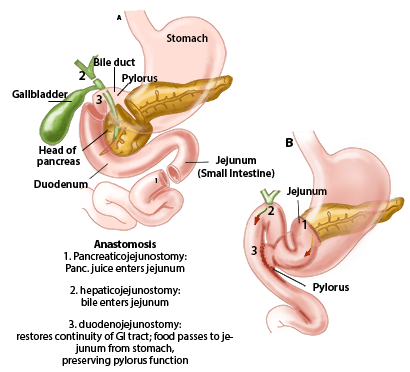
Pancreatic surgery is recommended for patients diagnosed with pancreatic cancer or those suffering from diseases of the pancreas, such as chronic pancreatitis, benign tumors, and cysts. Laparoscopic pancreatic surgery is an advanced procedure performed by surgeons with vast expertise. It may not be suitable in every case of pancreatic disease.
Pancreatic surgeries, even when done laparoscopically, are complex. As such, the duration of the surgery and the hospital stay will depend on the disease being treated and each patient’s post-operative condition. Generally, you can resume your normal routine between 7 to 10 days after the surgery.
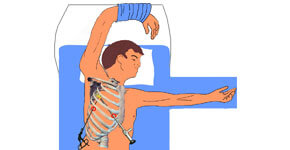
Also known as Video-Assisted Thoracoscopy (VATS), this is a procedure that can be used to diagnose any lung disease. It allows for internal examination, biopsy and surgical treatment of diseases related to the lungs, the pleura (envelope lining the lungs), esophagus or thymus. The internal examination is done using a thin laparoscope attached to a camera.
Thoracoscopy is the procedure of choice for conditions that require a biopsy of the lung or pleura; or for treating infections of the pleural lining (chronic empyema). VATS is also recommended for removal of esophageal tumors or the thymus in case of enlargement. However, before proceeding with surgery, you will need to consult our surgical experts who will advise investigations and tests as required.
As thoracoscopy is done via cuts no larger than 1 cm, there is much less pain than in open surgery. It is also easier to breathe and cough after undergoing a thoracoscopy which reduces the chances of developing infections such as pneumonia.
The surgery may last for 1 to 3 hours, depending on the disease and complexity of the procedure. The post-surgery stay in hospital and the recovery timespan will also vary from case to case. While you can move around a day after the surgery, the time taken to resume normal routine is different for every patient.
Some patients may require insertion of an Inter-Costal Drainage (ICD) tube in the chest, which will usually be removed prior to discharge. For every patient that undergoes VATS, it is important to do the chest exercises recommended by our physiotherapists. This will help them clear out any chest secretions and decrease the risk of infections.

Laparoscopic cholecystectomy is the recommended surgery for those with gallstone disease and its complications such as inflammation (cholecystitis), infections (empyema), perforation, etc.
Cholecystectomy was one of the first surgeries to be done laparoscopically. Since then there are very few situations in which open surgery was required. In any laparoscopic surgery, the procedure is performed through tiny cuts and no open wounds. Thus, the patient experiences less pain and an excellent cosmetic outcome along with a shorter recovery period.
Laparoscopic cholecystectomy surgery can be done as a daycare procedure. However, in case you have an infection of the gall bladder or any other conditions like hypertension, diabetes, etc. you may need to get admitted to the hospital one day prior to surgery and will be discharged the day after surgery. You will be able to walk around on the day of surgery itself and will be offered a normal diet from the following day. You will be able to resume your normal routine, including going back to work, within the next few days.
There are no specific precautions required after this surgery.
At Dr.Muffi Digestive Health Institute, we also provide laparoscopic treatment for complications of gallstone disease such as rupture of the gall bladder, development of fistula with the bile duct or duodenum, stones in the bile duct (choledocholithiasis) or infection (empyema). Our surgical team is also experienced in the laparoscopic treatment of other biliary diseases such as choledochal cysts.

Foregut diseases include GERD (Gastro-Esophageal Reflux Disease), para-esophageal hernia and achalasia cardia among several others and these conditions usually require surgical treatment. Laparoscopy is the technique of choice for treating all foregut diseases.
The surgery may last for about 60 to 120 minutes, depending on the condition of the disease and type of surgery being performed. Typically, you will be discharged a day or two after the surgery and you will be able to resume normal routine over the next few days.
You will be prescribed a specific diet for a few weeks after the surgery. This will include a gradual progression from a liquid to a semi-solid diet and finally, a regular diet.
Symptoms such as heartburn, chest pain, difficulty in swallowing, regurgitation of food, acid reflux, etc. are usually due to foregut diseases. At Dr. Muffi Digestive Health Institute, our team of surgical experts will examine you and recommend some tests that may include an esophago-gastro-endoscopy, manometry, 24-hour pH study, and barium swallow, among others. These are necessary for diagnosis as well as for planning further treatment.

Laparoscopic splenectomy is recommended in cases of splenic cysts and tumors like lymphoma. It might also be recommended for blood-related disorders such as hereditary spherocytosis, idiopathic thrombocytopenia, hypersplenism, etc.
This procedure is done through small cuts on the abdomen; the spleen is removed via a small incision (usually around 5 cm) which is made over the bikini-line. Since the procedure is performed through tiny cuts and no open wounds, the patient experiences less pain and an excellent cosmetic outcome along with a shorter recovery period.
The procedure lasts for about 90 to 120 minutes. You may need to stay in the hospital for 2 to 3 days after surgery, depending on your recovery progress.
It is advisable to avoid rigorous physical activities and contact sports for at least 2 to 3 weeks after surgery.
Prior to surgery, you will need to be immunized with pneumococcal, influenza and meningococcal vaccines. This is in order to prevent overwhelming post-splenectomy infection (OPSI). In case you develop a fever after a splenectomy, always speak to your doctor immediately and never take over-the-counter medication for it.
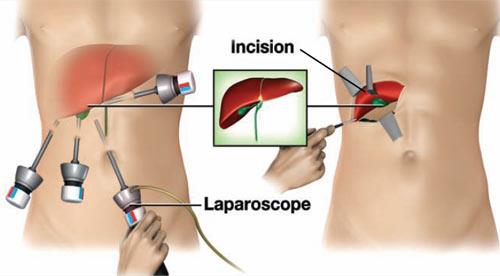
Laparoscopic liver surgery can be conducted in the case of cystic liver diseases such as a simple liver cyst or for tumors like hemangioma and sarcoma or even as a hydatid cyst liver treatment.
The surgery may take about 90 to 150 minutes. However, the duration of the surgery and the hospital stay will depend on the disease being treated and each patient’s post-operative condition.
it is advisable to avoid rigorous physical activities and contact sports for at least 2 to 3 weeks after surgery.
Here’s What Others Had To Say…

Pre operation weight
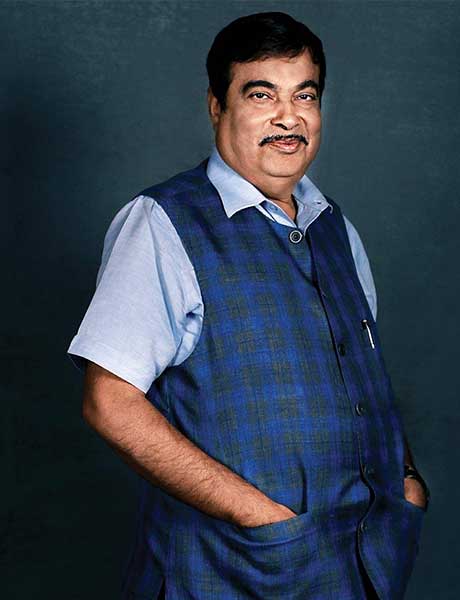
Current weight
Nitin Gadkari - Mumbai, India
Surgery Type - Laparoscopic Gastric Bypass (LGB)
Surgery Date - September 12, 2011
Was a long standing, uncontrolled diabetic on high dose of insulin+ 3 oral anti diabetic medications, despite which his sugars were uncontrolled. In addition he was also hypertensive (high BP) & on regular medications.
Post-surgery – He is off insulin and medications for diabetes and blood pressure.

Pre operation weight
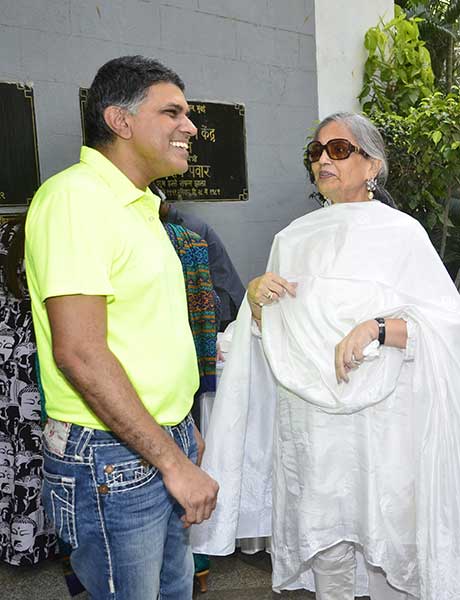
Current weight
Salma Khan - Mumbai, India
Surgery Type - Laparoscopic Gastric Bypass(LGB)
Surgery Date - January 23, 2013
Had great difficulty in walking around due to severe pains. In addition she was hypertensive and on regular medications for the same.
One year post operatively she is off all medications.
She loves her new self and the compliments she is being showered with. She is more independent than ever is making the most of new lease on life!!! Previous

Pre operation weight

Current weight
Sunaina Roshan - Mumbai, India
Surgery Type - Mini Gastric Bypass
Surgery Date - March 28, 2014
“I walk for one hour. I eat everything but in small portions because my stomach has shrunk. I can’t eat beyond a certain point. And this makes me feel lighter and confident,” she said.
"Now that’s what I call a transformation !! So so proud of you didi” - Hrithik Roshan

Pre operation weight
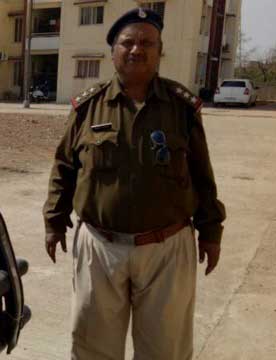
Current weight
Daulatram Jogawat - Mumbai, India
Surgery Type - Laparoscopic Banded roux – en – y Gastric Bypass
Surgery Date - March 02, 2017
“Earlier, I was unable to walk & had difficulty in breathing. After losing 55kgs, I am feeling fit, I can breathe easily & walk. I am following the instructions for diet & 1-hour walk, given by the doctors. My overall health has improved.
The entire Jogawat family and I would like to thank Dr. Lakdawala and his team for helping me live a healthier life"
While each surgery approach has its own set of pros and cons, the laparoscopic surgery is the most preferred over open surgery for the following reasons:
| LAPAROSCOPIC SURGERY | OPEN SURGERY |
|---|---|
| Surgeons make tiny incisions (or cuts) about 3-5 cms in size to insert a long, thin tube attached with a camera at its tip. | It requires a long incision, about 3-4 inches in size, for the surgeon to insert instruments and visualize the procedure through the incision. |
| Lesser pain due to smaller incisions. Blood loss is lesser due to increased magnification provided by the laparoscope | Increased pain due to larger wounds. Greater blood loss due to lack of magnification. |
| Smaller incisions reduce the risk of infections. | Large open wounds increase your susceptibility to infections. |
| Small wounds take less time to heal. Thus, the recovery period is fast. | Large wounds take more time to heal. Thus, the recovery period is slow. |
| This type of surgery requires shorter hospital stay due to faster recovery. | Open surgery may require an extended hospital stay due to the slow recovery process. |
Most gastrointestinal surgeries can be performed using laparoscopy technology including ulcerative colitis, rectal prolapse, Crohn’s disease, diverticulitis, hemorrhoids, cancer, etc. In the past, laparoscopic surgery wasn’t considered the best option for treating cancer patients due to questions raised concerning the safety of the procedure. However, recently, several studies have shown that laparoscopy is a safe approach for cancer patients.
Laparoscopy can be used to identify and diagnose various gastrointestinal disorders, especially when non-invasive methods such as ultrasound, MRI scan, CT scan, etc. have failed. Laparoscopy provides enough information or insight into a diagnosis. Alternatively, it can also be used to take a tissue sample or a biopsy from a specific organ in the abdomen such as the appendix, the liver, the gall bladder, the stomach, the pancreas, etc.
The recovery time after laparoscopy is different for every patient as it depends upon several factors such as the reason for the procedure, the patient’s body parameters and the level of his/her complications if any. Generally, if the procedure was done for the purpose of diagnosis, you will be able to resume your routine within 4 -5 days. However, if laparoscopy is done for treating a certain condition, then the recovery time depends upon the type of treatment. For minor surgeries, the recovery may take about 3 weeks, while for major surgeries you will be able to resume your normal activities only after about 12 weeks.
Even though laparoscopy is more convenient for the patient and the surgeon in comparison to open surgery, there are some risk factors that may affect you. Typically, these risk factors are the side effects of laparoscopic surgery such as bleeding, damage to internal tissues, infection, etc. Therefore, no sooner you experience any fever or chills, abnormal abdominal pain, constant nausea, breathlessness, swelling or redness, lightheadedness, etc. you must contact your doctor to avoid any consequences. Even though the procedure is safe for most patients, you must learn about the side effects of laparoscopic surgery and take the necessary precautions. However, for patients who have undergone prior abdominal surgeries, the laparoscopic approach may turn out to be more risky than beneficial. Thus, you must always consult your doctor before choosing any surgical procedure.